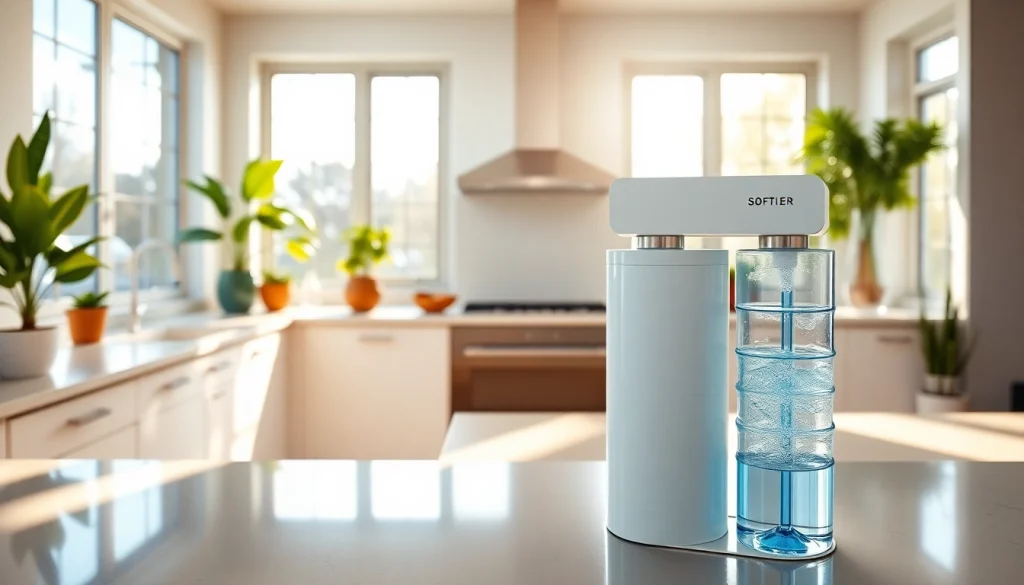Benefits of Soft Water for Whole House Systems That Transform Your Home Environment

Understanding Soft Water for Whole House Applications
Definition and Benefits of Soft Water
Soft water is water that has had its mineral content, particularly calcium and magnesium, significantly reduced through a process known as water softening. Unlike hard water, which can leave behind limescale on fixtures, appliances, and pipes, soft water is less likely to cause buildup, allowing appliances to operate more efficiently. The benefits of soft water extend beyond mere aesthetic improvements; it has positive implications for health, the environment, and even household budgets. Those considering making the switch often find that soft water for whole house applications can lead to a variety of improvements in daily life.
How Soft Water Works in Home Systems
In a typical home water softening system, the principles of ion exchange are employed. Hard water passes through a resin bed containing sodium ions. As the hard water flows through, the calcium and magnesium ions in the water are exchanged for sodium ions, effectively softening the water. This process not only helps to mitigate the impacts of hard water but also ensures a greater longevity for plumbing fixtures and appliances. Home units can be installed at the point of entry to the home, thereby softening all the water that enters, or at specific points of use, depending on the homeowner’s needs.
Common Misconceptions about Soft Water
Despite the benefits of soft water, several misconceptions surround its use. One of the most persistent myths is that soft water is “bad” for health due to its sodium content. In reality, the amount of sodium introduced into the water is typically so small that it poses negligible health risks for most individuals. Another common misunderstanding is that soft water lacks minerals. However, while it’s true that minerals like calcium and magnesium are removed, these are often adequately provided through diet. Additionally, some believe that soft water is not effective for cleaning, but in fact, it can enhance the sudsing properties of soaps and detergents, leading to better cleaning results.
Why Choose Soft Water for Whole House Solutions?
Health Benefits of Soft Water
Switching to soft water presents a variety of health benefits. For those with sensitive skin or certain skin conditions, soft water can help reduce irritation as it contains fewer dissolved minerals that can cause dryness. Additionally, soft water often improves the effectiveness of soaps and shampoos, leading to better cleansing and moisturizing of the skin and hair. Soft water can also lead to softer laundry, reducing skin irritants and providing a more comfortable experience for those with allergies.
Environmental Impact of Soft Water Usage
Using soft water can have a positive environmental impact as well. The efficiency of soft water can lead to lower energy and water usage. Appliances such as washing machines and dishwashers operate more effectively with soft water, often requiring less detergent and lower amounts of energy to achieve the same cleaning results. This reduction in usage can help to conserve resources and reduce utility bills, thus benefiting both the environment and household finances.
Cost-Effectiveness of Soft Water Systems
Installing a soft water system can seem like a significant initial investment, but the long-term cost savings can make it worthwhile. By reducing wear and tear on appliances due to mineral buildup, homeowners can extend the lifespan of their equipment and reduce repair costs. Furthermore, less detergent use and minimized energy costs contribute to the overall savings that come with a soft water system. Many households realize that after making the switch, the benefits far outweigh the costs involved in installation and maintenance.
Installation Process for Soft Water Systems
Choosing the Right System for Your Home
Selecting an appropriate water softener involves several considerations. Factors to assess include the hardness level of the water, the size of the household, and specific needs such as water consumption for irrigation or cooking. There are different types of systems, including salt-based ion exchange systems, salt-free systems, and reverse osmosis systems, each of which is tailored to different scenarios and preferences. Consulting a water treatment professional can aid in determining the best fit for your particular situation.
Step-by-Step Installation Guidelines
Installing a water softening system can often be accomplished by a DIY enthusiast, but following guidelines is crucial for proper function. The general process involves:
- Choosing a suitable location that is easily accessible and near the main water line.
- Shutting off the main water supply line to avoid flooding.
- Installing bypass valves to facilitate the water softening process.
- Connecting incoming and outgoing water lines, typically following the manufacturer’s instructions closely.
- Filling the brine tank with salt, if applicable, and programming the softener settings as required.
- Turning the water back on and checking for leaks, along with testing the system to ensure it is functioning properly.
Maintenance Tips for Longevity of Your System
Proper maintenance of a water softening system is integral to its longevity and efficiency. Regularly check brine levels and replenish salt as needed, typically every few months. It’s also recommended to clean the resin bed periodically and check for any salt bridges that can form in the brine tank. Furthermore, regular system checks, including evaluating the regeneration cycle, can ensure optimal function and help prevent any unexpected interruptions in service.
Performance Metrics to Measure Soft Water Effectiveness
Water Softness Analysis Techniques
To evaluate the effectiveness of a water softening system, it’s essential to measure water softness. Common methods include using home testing kits, which can effectively measure the concentration of calcium and magnesium ions, or utilizing a professional water analysis service for more detailed results. The goal is to achieve a water hardness level of 0–3 grains per gallon, which indicates a successful softening process.
Comparison with Hard Water
Soft water and hard water exhibit significantly different characteristics. Hard water contains high levels of calcium and magnesium, leading to various issues such as scale buildup, soap scum, and inefficient heating in appliances. Conversely, soft water does not create these problems, allowing for better soap lathering and greater detergent effectiveness. It’s useful to observe changes in energy bills and the performance of appliances over time to truly appreciate the differences soft water offers.
User Testimonials and Experiences
User feedback is often a compelling indicator of the advantages associated with soft water systems. Many households report noticeable improvements in skin conditions, laundry softness, and appliance longevity. Additionally, positive experiences typically include the ease of maintenance and the satisfaction of decreased monthly utility costs, providing an overall enhanced quality of life. Real-world testimonials can serve as a valuable resource for potential users considering the transition to soft water.
Future Trends in Whole House Water Solutions
Advancements in Water Filtration Technology
As technology evolves, so do water filtration systems. Innovations in water softening methods, such as smart systems that can monitor water quality in real-time, are making it easier for homeowners to manage their water supply. New materials and processes are enhancing both the efficiency and longevity of water softeners, making them more accessible and user-friendly. Future developments may also focus on reducing the environmental impact of salt usage, integrating sustainable practices into water treatment technologies.
Eco-Friendly Practices in Water Softening
With increasing awareness of environmental issues, the demand for eco-friendly water treatment solutions continues to rise. Many companies are developing systems that minimize salt usage and optimize water discharge, thereby reducing the environmental footprint associated with traditional softening practices. Additionally, salt-free softeners that employ conditioning technologies are gaining traction as sustainable alternatives, offering homeowners options that align with green living principles.
Community Awareness and Education on Soft Water
The community’s perception of water quality and the benefits of water softening is critical for broad adoption. Educational outreach efforts by local water treatment professionals can enhance understanding, enabling homeowners to make informed decisions about their water needs. Discussions about the importance of water quality encompass not just personal health benefits, but also economic savings and environmental sustainability. Raising awareness through workshops, seminars, and promotional campaigns can foster a culture of proactive water management within communities.






